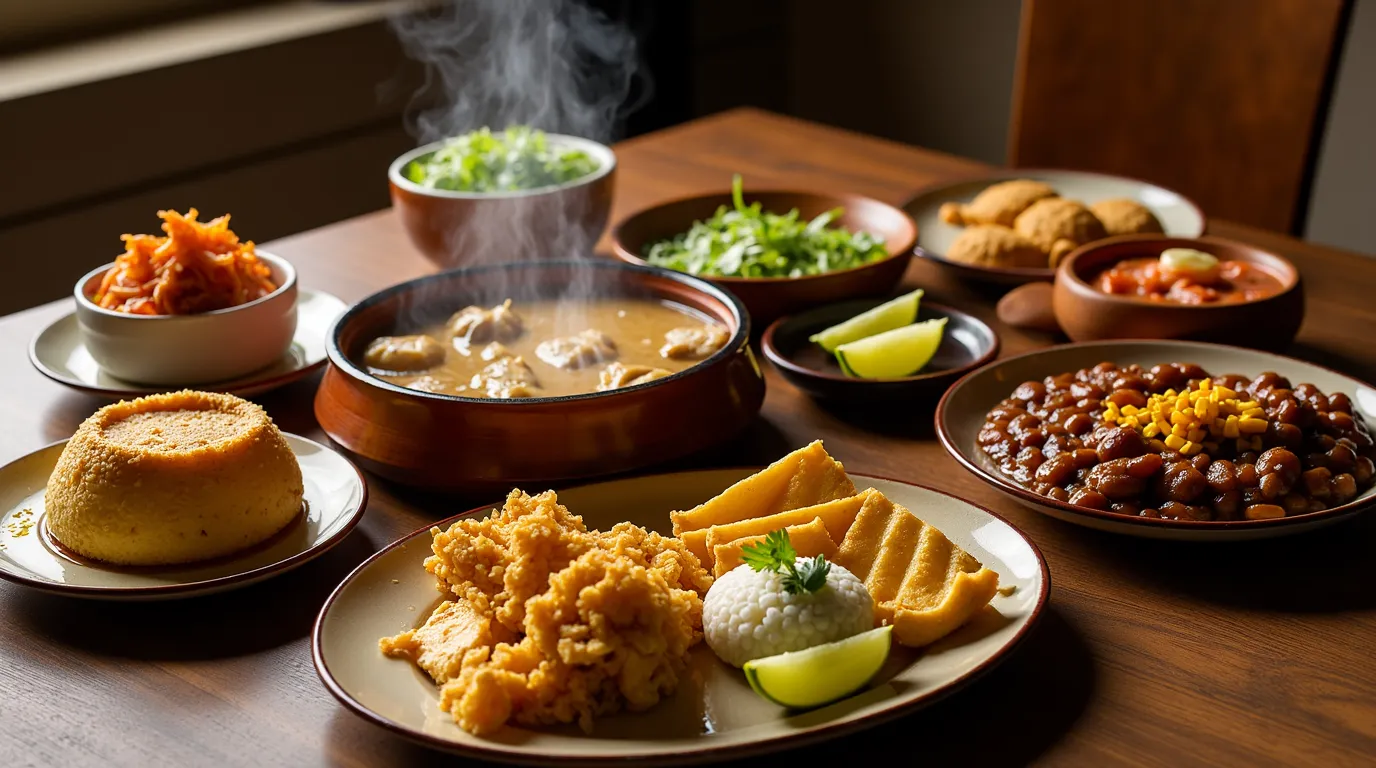Table of Contents
Table of Contents
Introduction
Dominican cuisine is a tapestry of flavors, influences, and traditions that come together to create a truly unique gastronomic experience. From the lively streets of Santo Domingo to the quiet fishing villages along the coast, food is central to the Dominican way of life. It reflects the country’s rich heritage, its diverse cultural makeup, and its abundant natural resources.
When you dive into Dominican cuisine, you will discover a fusion of Spanish, Taíno (the indigenous people), and African elements that date back centuries. This blend of flavors results in dishes that are both comforting and exciting—recipes steeped in tradition but constantly evolving. Whether you’re sampling a plate of mangú (mashed plantains) at breakfast or indulging in a hearty stew for dinner, you’ll be tasting the story of an island that has welcomed—and continues to welcome—various cultural influences.
In this article, we will explore Dominican cuisine in depth, from its historical roots to modern-day evolutions. You will learn about key ingredients, regional variations, and essential dishes that form the backbone of daily Dominican life. We will also delve into table rituals, customs, and significant events where food takes center stage, as well as discuss emerging trends that are reshaping traditional fare. By the end, you should be equipped with both cultural insights and practical tips for recreating Dominican flavors in your own kitchen. Prepare to embark on a flavorful journey that shows just how diverse, dynamic, and unforgettable Dominican cuisine can be.
Culinary Context and History
Ancient and Colonial Influences
The story of Dominican cuisine begins with the Taíno people, the island’s original inhabitants. They relied heavily on the land and sea for sustenance, cultivating crops such as yucca, corn, peppers, and tropical fruits. The Taínos smoked, roasted, and sun-dried their food, thus forming the earliest culinary traditions on the island.
With the arrival of Spanish colonizers in the late 15th century, wheat, olives, dairy, and new livestock were introduced. Sugarcane plantations also became widespread, changing the local food scene and economy. Later, the forced migration of African peoples contributed further to the development of unique cooking techniques, seasonings, and staple dishes. This tripartite influence—Taíno, Spanish, and African—would ultimately form the foundation of Dominican cuisine, creating a gastronomic mosaic still evident in the flavors you taste today.
Post-Colonial Evolution
After the Dominican Republic gained independence, the country continued to experience new gastronomic influences through trade and migration. Middle Eastern communities arrived with spices and recipes, while economic exchanges with other Caribbean islands promoted the sharing of ingredients like plantains, beans, and tropical tubers. Over time, Dominican cooks adapted these outside elements to fit local tastes and seasonal availability.
Despite these external influences, traditional Dominican cuisine has maintained a strong foundation rooted in home cooking, with many families passing recipes from generation to generation. While modern supermarkets and global imports have become more common, street markets and local vendors still play a crucial role in daily life. The interplay between tradition and modernity continues to shape the national food landscape, offering both comforting classics and innovative new dishes.
Regional Variations
Dominican cuisine can differ significantly based on the country’s geography. In the northern region, or the Cibao Valley, the fertile land produces an abundance of vegetables, fruits, and grains. This agricultural wealth means dishes here often emphasize fresh produce and hearty portions of rice and beans.
In the south, where the climate can be drier, meats like goat (chivo) gain prominence. The province of Azua, for instance, is known for its goat-based stews and soups. Vegetables are still important, but meats and tubers often take center stage.
The eastern region, famous for its sugarcane plantations and coastal resorts, highlights seafood and fish. Coconuts are especially abundant here, resulting in coconut-based curries and desserts that carry a sweet, creamy touch. Meanwhile, the western region, which borders Haiti, experiences a cultural crossover. Certain Haitian cooking techniques and spices can be found in stews and marinades, adding extra layers of complexity to local meals.
These distinct regional elements come together under the broader umbrella of Dominican cuisine, offering a range of flavors and techniques that vary from one area to another. Each region has its specialties and culinary trademarks, making a tour around the island a rewarding adventure for food lovers.
Key Ingredients and Local Products
Staples of Dominican Cuisine
Central to Dominican cuisine are ingredients like rice, beans, and plantains. Rice is such a staple that lunch is often referred to simply as “la bandera,” meaning “the flag,” which consists of white rice, stewed beans, and meat, symbolizing the national identity on a plate. Plantains, both green (plátanos verdes) and ripe (plátanos maduros), appear in countless forms: boiled, mashed, fried, or baked. They are incredibly versatile, forming the base of famous dishes like mangú (boiled green plantains mashed with butter or oil) and tostones (green plantains sliced and fried twice).
Beans—most commonly red or black—are used in stews, soups, and sauces. Another iconic component is yucca (cassava), a root vegetable that can be boiled, mashed, or fried. Yucca not only reflects indigenous Taíno culinary methods but also stands as a testament to how Dominican cooking preserves its ancestral roots.
Proteins and Seafood
Meat plays a significant role in Dominican cuisine, with pork, chicken, and beef featuring in daily meals. Pork is commonly roasted in celebratory gatherings, especially during the Christmas season, while chicken is favored in home cooking for its affordability and versatility. Beef appears in hearty stews like sancocho, a slow-cooked soup that combines several types of meat with vegetables and tubers.
Seafood is especially prized in coastal areas, where fish like red snapper, grouper, and shrimp are readily available. These are often seasoned with garlic, onions, bell peppers, and a squeeze of lime. In the eastern region, you might find fish simmered in coconut milk, reflecting local produce and a preference for creamy, tropical notes.
Herbs, Spices, and Seasonings
Dominican cuisine isn’t typically described as spicy in the way Mexican or Thai cuisines can be, but it is richly flavored. Common seasonings include garlic, onions, bell peppers, cilantro (known locally as cilantro ancho or culantro), oregano, and the widely used sazón (a seasoning blend of spices). Adobo, a mixture of garlic, oregano, salt, and vinegar, is another staple marinade for meats and fish. These herbs and spices lend depth and aroma without overwhelming the palate with heat, striking a balance that appeals to a broad range of taste preferences.
Fruits and Vegetables
The Dominican Republic’s tropical climate yields a bounty of fruits, from the ubiquitous plantains to exotic varieties like passionfruit, guava, and mango. Vegetables such as peppers, squash, and root crops like batata (sweet potato) feature prominently. Seasonality affects what is most commonly available and affordable at local markets, so dishes naturally shift with the harvest calendar. During mango season, for example, you’ll see this fruit used in both savory and sweet preparations, from salsas to desserts.
Tips for Finding Ingredients
For those looking to replicate Dominican cuisine at home, finding fresh, authentic ingredients is key. Local Latin American grocery stores or specialty markets are excellent places to look for plantains, yucca, and tropical spices. You may also find certain shelf-stable items, such as sazón packets, adobo seasoning, and canned coconut milk, in larger supermarkets’ international aisles. If fresh herbs like culantro are unavailable, standard cilantro can be substituted, albeit with a slightly milder flavor. Purchasing peak-season produce not only ensures the best taste but also supports the traditional rhythm of Dominican cooking.
Must-Try Traditional Dishes
La Bandera
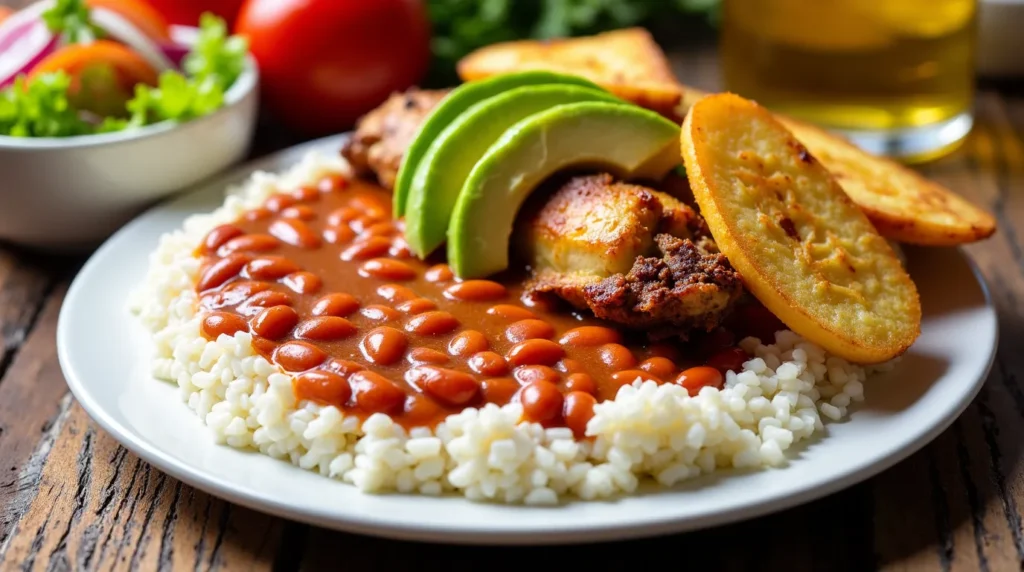
Often referred to as the national dish, la bandera (which literally translates to “the flag”) perfectly showcases the essence of Dominican cuisine. This meal typically consists of white rice, stewed beans (habichuelas guisadas), and meat (chicken, beef, or pork). The colors of the dish—white rice, red beans, and brownish meat—reflect the Dominican flag’s colors in a metaphorical sense.
- History: The name is said to have originated from the pride Dominicans take in their daily meal, akin to how one might honor a national symbol.
- Characteristics: It’s a comforting, balanced plate that almost every Dominican family enjoys, especially at lunchtime.
- Ingredients: White rice, red beans, a choice of meat, onions, garlic, peppers, oregano, and tomato sauce.
- Regional Variations: Some variations include adding avocado slices, fried plantains, or salad.
Simplified Recipe for Stewed Beans (Habichuelas Guisadas)
- Heat oil in a pot and sauté minced garlic, diced onions, and peppers.
- Add canned or pre-cooked red beans along with their liquid.
- Stir in a spoonful of tomato paste or sauce, oregano, and salt.
- Let the mixture simmer until it thickens. Adjust seasonings to taste.
Serve these flavorful beans alongside steamed white rice and your preferred protein.
Sancocho
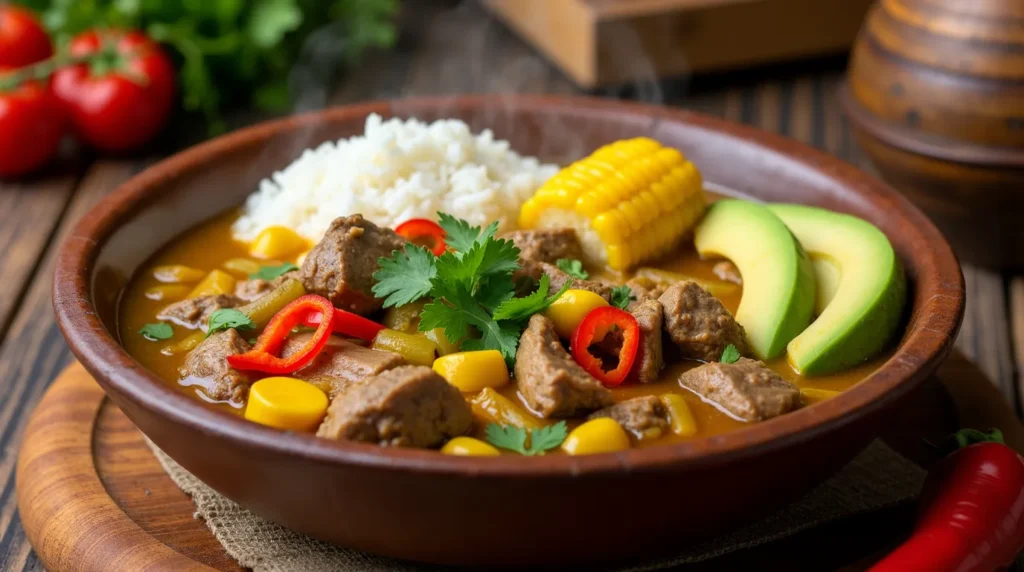
Another cornerstone of Dominican cuisine, sancocho is a hearty stew often reserved for special occasions or weekend family gatherings. It can include up to seven types of meat, although simpler versions may use just beef and chicken. Root vegetables like yucca, yautía (taro), and potatoes form the base, along with plantains and corn on the cob.
- History: Sancocho is believed to have Spanish and Canary Island roots, but it has since become a uniquely Dominican staple.
- Characteristics: Rich, warming, and brimming with complex flavors from slow cooking.
- Ingredients: Various meats (beef, chicken, pork, even goat), root vegetables (yucca, yautía, potatoes), green plantains, corn, garlic, onions, cilantro, and oregano.
- Regional Variations: Some areas add or omit certain root vegetables based on availability. Coastal regions might include seafood versions, although that’s less common.
Simplified Recipe Tip:
- Brown the meats first in a large pot with seasoning.
- Add root vegetables and enough water or broth to cover everything.
- Simmer for at least an hour or until the vegetables are tender and the meats are fully cooked.
- Finish with fresh cilantro or culantro for an aromatic kick.
Mangú
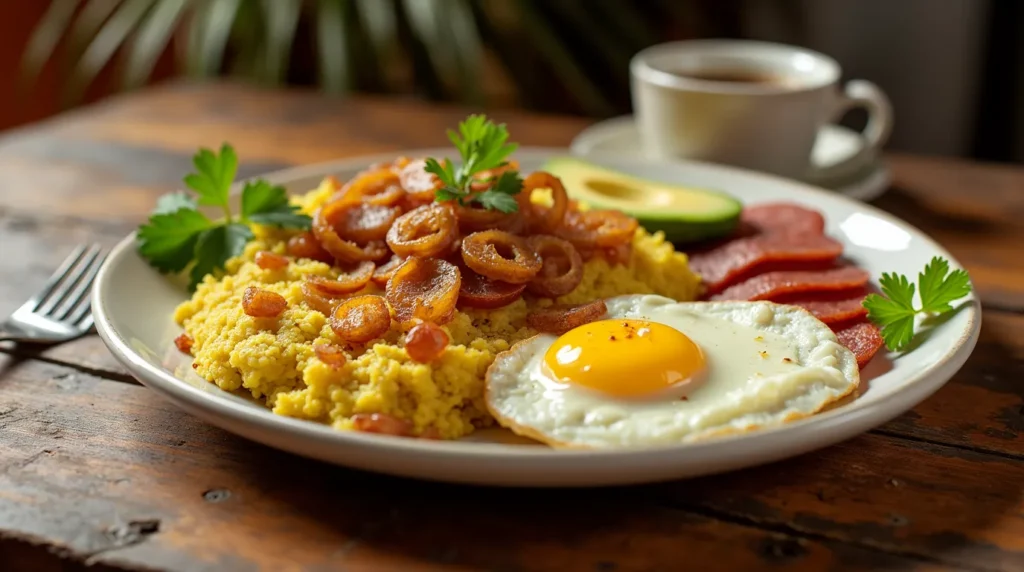
Mangú is the quintessential Dominican breakfast dish made from boiled green plantains that are mashed with butter or oil. It’s often served with a side of los tres golpes—fried cheese, fried salami, and fried eggs—forming a hearty, protein-rich plate that fuels Dominicans throughout the day.
- History: Mangú has African origins, with similar mashed-plantain dishes found in various parts of the African continent.
- Characteristics: Creamy, savory, and comforting, perfect for breakfast but also enjoyed at any time of day.
- Ingredients: Green plantains, butter or oil, salt, sometimes a pinch of garlic.
- Regional Variations: Some cooks add onions cooked in vinegar on top; others might garnish with fresh cilantro.
Quick Preparation:
- Peel and boil the plantains until soft.
- Mash them immediately with butter and a bit of the water you used for boiling.
- Season with salt to taste. Serve hot with your choice of side dishes.
Pastelón de Plátano Maduro
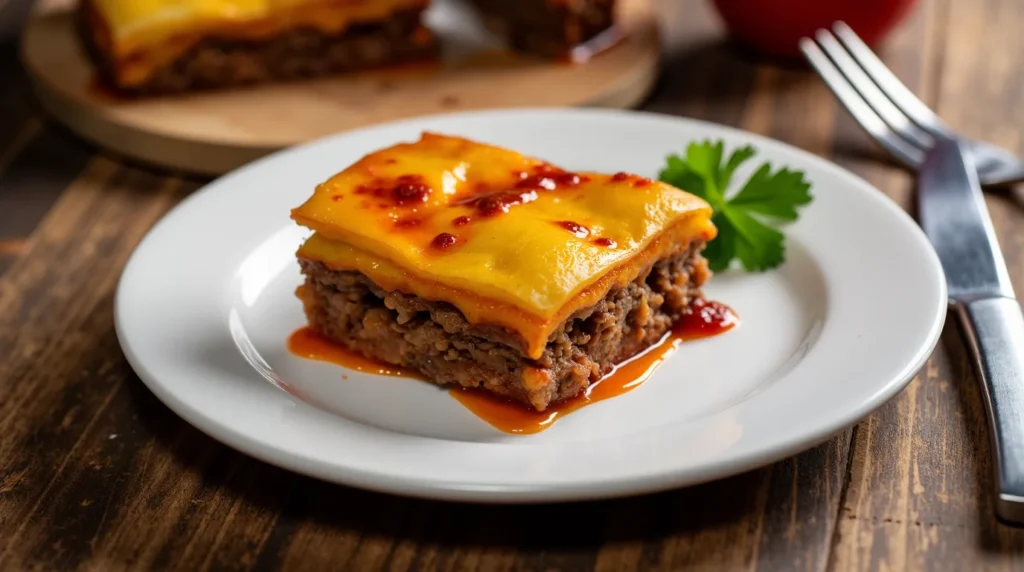
For those who love sweet and savory contrasts, pastelón de plátano maduro is a must-try. Ripe plantains are boiled or fried, then layered with seasoned ground beef and cheese, creating a casserole reminiscent of lasagna but with a tropical twist.
- History and Influences: Likely inspired by Spanish and Creole cooking techniques, pastelón has become popular throughout the Caribbean.
- Characteristics: Sweetness from the ripe plantains balances the savory, spiced ground beef.
- Ingredients: Ripe plantains, ground beef (seasoned with garlic, onion, peppers, tomato sauce), cheese, eggs, and butter.
- Regional Variations: Some include raisins in the filling for added sweetness, while others add bell peppers or olives for a sharper flavor.
Defining Characteristics of Dominican Cuisine
Dominican cuisine is known for its bold flavors—garlic, onions, peppers, oregano—and for striking a balance between savory and subtle sweetness. While it does incorporate spices, it is not “spicy hot” in the way certain Latin American or Asian cuisines can be. Instead, the warmth comes from aromatic seasonings that enhance the natural flavors of meats, vegetables, and grains.
Key Flavor Combinations:
- Garlic and Oregano: Form the backbone of many marinades and stews, providing depth without overpowering.
- Cilantro (Culantro) and Onion: Add freshness and a hint of pungency that complements the starchy nature of plantains and root vegetables.
- Tomato Sauce and Bell Peppers: Give a tangy sweetness that rounds out dishes like beans and stews.
These flavor profiles make Dominican cuisine appealing to a wide audience. It’s robust enough for food enthusiasts seeking bold new tastes but mild enough for those wary of intense heat. The interplay of textures—from the creaminess of mangú to the crisp edges of fried plantains—adds another dimension of enjoyment.
Tips and Highlights to Encourage People to Try This Cuisine
- Cultural Immersion: Food in the Dominican Republic is a communal experience, often shared with friends and extended family. By tasting Dominican cuisine, you connect not just with new flavors but also with a warm and vibrant social culture.
- Rich History: Each bite tells a story of the island’s past—from indigenous Taíno roots to Spanish, African, and other global influences. Exploring this culinary mosaic deepens your appreciation for the country’s heritage.
- Adaptable Recipes: Many Dominican dishes can be adapted to suit dietary preferences, making them accessible to a broad range of eaters. Mangú, for example, can be made vegan by omitting butter, and sancocho can be adapted with vegetable broth and additional root vegetables instead of meat.
- Healthy and Wholesome: Although some dishes can be fried or feature richer proteins, there’s an abundance of fresh produce, beans, and grains central to Dominican cuisine. Balanced meals like la bandera provide essential nutrients in a single plate.
- Ease of Preparation: Many dishes require basic cooking techniques such as boiling, stewing, and frying. This approach makes it simpler for culinary beginners to get started without feeling overwhelmed.
- Travel Inspiration: Trying Dominican cuisine might just inspire you to visit the country, where you can experience fresh seafood along the coast, feast on hearty meals in the mountains, or enjoy street food in bustling city squares.
Table Rituals and Customs
Meal Structure
In the Dominican Republic, meals are spread throughout the day, often starting early with a substantial breakfast:
- Breakfast (Desayuno): Many Dominicans begin their day with mangú, alongside fried cheese, salami, and eggs—commonly referred to as los tres golpes. Alternatively, bread with cheese or avocado might suffice for a lighter option.
- Lunch (La Comida or El Almuerzo): The most significant meal of the day, typically served between noon and 2 p.m. This is when “la bandera” often appears. Given its importance, people usually sit down to a full meal, sometimes returning home from work to eat with family.
- Afternoon Snack (Merienda): A small snack, such as fruit, a pastry, or a cup of coffee, helps tide people over until dinner.
- Dinner (Cena): Typically lighter than lunch, dinner may consist of leftovers from lunchtime or simpler fare like sandwiches, soup, or a smaller portion of rice and beans.
Social Etiquette
Dominicans pride themselves on hospitality and warmth. If you’re invited to a family meal:
- Greeting: A friendly hug or a kiss on the cheek is common when meeting people.
- Gestures to Avoid: Refusing food or drink multiple times can be interpreted as impolite, as hosts take joy in providing for their guests.
- Shared Dishes: Many meals are served family-style, with large platters in the center of the table.
During special gatherings, conversation is lively, and it’s not unusual for meals to stretch out with multiple courses or rounds of coffee. Dominicans often linger at the table, sharing stories and laughter long after the main meal is finished.
Holidays and Celebrations
- Christmas: A highlight of the year, families gather for a festive feast typically featuring roast pork (lechón asado), Russian salad (ensalada rusa), and pasteles en hoja (a plantain- or yucca-based tamal-like dish).
- Easter (Semana Santa): Many families head to the countryside or beaches, with fish and other seafood becoming more prominent. A special sweet dish known as habichuelas con dulce (sweet cream of beans) is also made during this time.
- Patron Saint Festivals: These local celebrations differ from town to town, but invariably, food stalls serve regional specialties, sweets, and drinks, bringing communities together.
Modern Trends and Culinary Fusions
Dominican cuisine continues to evolve as the country opens itself up to global culinary exchanges. Many Dominican chefs travel abroad for formal training, bringing back new techniques and flavors to infuse into local dishes. Upscale restaurants in Santo Domingo may offer modern interpretations of classics, plating mangú in gourmet styles or experimenting with sancocho reductions.
International Influences
Along with historical influences from Africa, Spain, and the Taínos, more recent immigrants from Asia, the Middle East, and other parts of Latin America have left their mark on Dominican cuisine. For instance, you might find dishes that incorporate soy sauce, chili paste, or Middle Eastern spices, seamlessly blending them with traditional Dominican seasonings.
Health and Sustainability
Globally, there is an increasing shift toward organic produce, farm-to-table dining, and vegetarian or vegan options. The Dominican Republic is no exception. Farmers’ markets selling locally grown, pesticide-free fruits and vegetables are becoming more popular, particularly in urban centers like Santo Domingo and Santiago. Some restaurants now highlight vegetarian sancocho or vegan pastelón made with plant-based protein.
Young Chefs and Innovation
A new generation of Dominican chefs is reimagining local cuisine. They might serve a deconstructed pastelón, present sancocho as a refined soup course, or create innovative desserts using tropical fruits in ways that push boundaries. These culinary pioneers are attracting global attention, proving that Dominican cuisine can be both traditional and avant-garde.
Conclusion and Call to Action
Dominican cuisine is a vibrant tapestry woven from centuries of cultural exchange and local traditions. From the foundational simplicity of la bandera to the celebratory complexity of a seven-meat sancocho, the food of this island nation combines warmth, richness, and adaptability. Regional differences further enrich the experience, whether you’re sampling coconut-infused seafood in the east or savoring goat stew in the south.
We’ve explored the history, key ingredients, and defining characteristics that make Dominican cuisine a standout in the Caribbean. We’ve examined traditional dishes and offered tips for sourcing ingredients, as well as highlighted the social and cultural customs that transform an ordinary meal into a communal feast. Modern trends and international influences continue to push the boundaries, ensuring that Dominican cuisine remains as dynamic as the country itself.
Now that you’re equipped with this knowledge, we encourage you to explore Dominican cuisine in your own kitchen or at a local restaurant. Seek out plantains, experiment with sazón, and immerse yourself in the comforting flavors that have been passed down through generations. If you’ve already tried some Dominican dishes or have a cherished recipe to share, we’d love to hear about your experiences. Let us know what flavors captivated you, which dishes you plan to master, or what questions you still have.
Looking ahead, we plan to dive deeper into the vibrant world of Dominican street food in an upcoming article, exploring how snacks and quick bites reflect the country’s culinary heritage in an on-the-go format. Stay tuned, keep experimenting with new flavors, and above all, enjoy the hearty embrace of Dominican cuisine.

